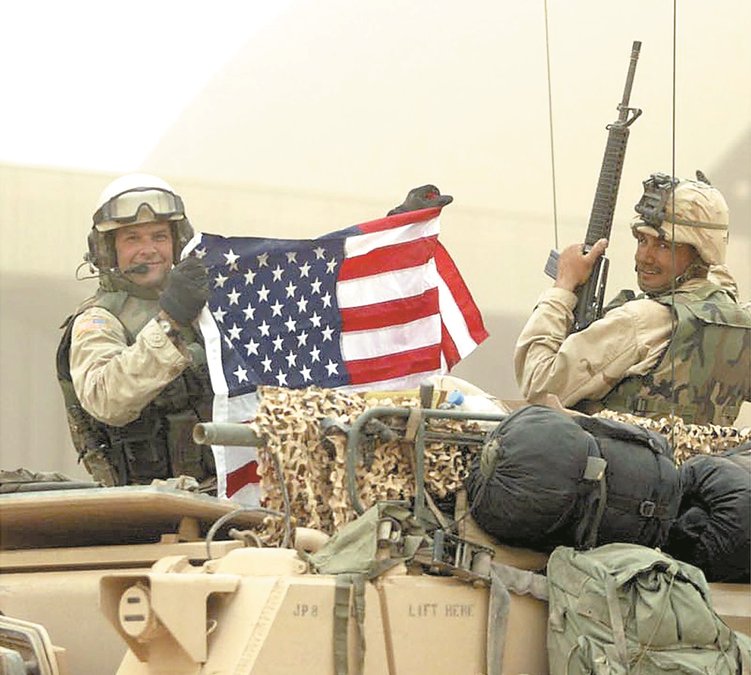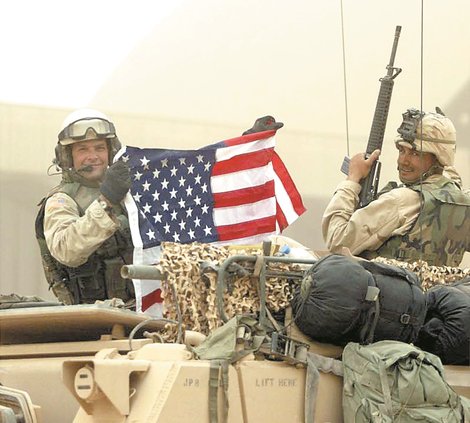FORT STEWART – It had been 20 years since Scott Rutter led these same men through Iraq and into Baghdad, fighting sandstorms, Iraqi soldiers and irregulars and the wear and tear that comes from 300 miles on the road in three weeks.
Over the weekend, Rutter and the many of his former soldiers in 2/7 Infantry Battalion gathered to remember their accomplishment from 20 years before and to remember those among them who fell along the way to overthrowing Iraqi dictator Saddam Hussein.
“I was the old man then,” Rutter said. “I’m 60 now.”
But the pride he had in his soldiers 20 years ago has endured the two decades since 3rd ID soldiers invaded Iraq and captured an enemy’s capital.
“Every day I think about it,” Rutter said. “And to just highlight it, the success of our task force was the many great soldiers, the great noncommissioned officers, decentralized operations, going to the enemy, developing the situation and the confidence that leaders instilled n them in order to do what was right.”
Though the division had a number of fights with Iraqi forces along the way, among the biggest targets 2/7 Infantry and the 1st Brigade had was the capture of Objective Lions, known then as Saddam Hussein International Airport and now called Baghdad International Airport The seizure of the airport – which included fending off an attack by several Iraqi T-72s that crept to close range under the cover of darkness – was a key moment in the battle.
“We didn’t have a good picture on the enemy at the airport,” Rutter said. “But we developed the situation. Individuals were focused on finding the enemy and doing what they needed to do. We lost several great soldiers on the route moving up, as well as individuals at the airport.”
It was at their airport where Sgt. 1st Class Paul Smith of the 11th Engineer Battalion, who company was attached to the 2/7 Task Force, was killed in battle, fending off a massive counterattack as he and other engineers attempted to construct a hasty prisoner-of-war pen. Smith, manning a .50-caliber machine gun atop a damaged M113 armored personnel carrier, was credited for killing more than 50 enemy soldiers, and possibly staving off a further advance on the brigade command post. Smith suffered a mortal wound near the battle’s close.
He was the first soldier to be awarded the Medal of Honor for Operation Iraqi Freedom.
The capture of the airport was followed by the two Thunder Runs from the 2nd Brigade. The first, on April 5, probed Iraqi defenses, and the tanks, Bradleys and other armored vehicles regrouped at the newly-won airport before returning to base south of Baghdad.
The second Thunder Run, on April 7, ended at several key significant locations, including the Republican Palace, in Baghdad. Instead of an attack to test Iraqi strength, the second Thunder Run was meant to crush it and seize key parts of the capital, though it came with fierce fighting at three key intersections to keep the task force supplied.
“We felt, ‘this is it, we’re at the airport, we’re on the Thunder Runs,’” Rutter said.
After destroying the Republican Guard on the west side of Baghdad, Task Force 2/7 joined up with the 2nd Brigade, coming all the way around the airport for another fight at Objective Curly, an intersection vital along the supply route into Baghdad.
“We were right there, focused, destroying the enemy to allow the rest of the Thunder Runs to take place,” Rutter said.
When the division crossed into Iraq less than three weeks earlier, Rutter said his message to the troops was to fight as they had trained and to focus on the basics.
“We focused on we’ve got to take care of each other,” he said. “We’ve got our wingman, we’ve got our dismounted infantry, our mounted infantry, working together collectively. There was a lot of anxiety. There was a lot of uncertainty.”
The division had prepared for months for its mission, dating back to exercises in Kuwait, at the National Training Center at Fort Irwin, and on the ranges of Fort Stewart.
“(We) could not have done it, could not have done it. without the support of Fort Stewart,” Rutter said.
The support of the home base included the family support groups, which also proved invaluable to the soldiers thousands of miles away in combat.
“I was blessed with a great family support group,” Rutter said, adding that the family support groups also were constructed and led from the bottom up along the chain of command. “We came together and we maintained contact. We made sure that we had the right information coming back. Information is key. They were finding out stuff before we did.
The Iraqi military dissipated not long after the second Thunder Run, though it launched a ferocious counter attack on April 8 that was overwhelmed.
The next day, soldiers from the Marne Division and marines from the 1st Marine Expeditionary Force linked up in Baghdad. The Iraqi regime was on the run and Saddam Hussein had been ousted from power.
It completed the greatest advance in combat in military history.
“I’m blessed, I’m blessed with all of them here,” Rutter said, with many of his former soldiers around him. “This task force, the mighty Cottonbalers, the airport and the Thunder Run … no one else did that.”


Division ‘moved fast,’ current brigade CO says
Today, Col. David Key is commander of the 3rd Infantry Division’s 3rd Sustainment Brigade, in charge of thousands of soldiers.
Twenty years ago, he was a young officer, “sitting in a seat as a student in the logistics captain’s career course, looking at a board of assignments,” he said.
One duty post stuck out to him – 3rd Infantry Division, Fort Stewart.
“If you’re watching the news and you don’t have a right shoulder patch and you’re looking for the opportunity to get a right shoulder patch, you’re only looking at one unit at the time,” he said, “and that was the 3rd Infantry Division.”
There was one opening for the division. Key took it. He reported to the 3rd ID and deployed shortly thereafter to be the assistant division transportation officer on the division staff during Operation Iraqi Freedom 1.
Key was an enlisted man in the Georgia National Guard for four years after leaving high school in Douglasville. As a private, he looked up at his unit leaders. Some were veterans of the Vietnam War. Others had been in Operation Desert Shield/Desert Storm.
“And you’d never thought you’d get that opportunity again,” he said. “If you have that experience, people look at you different. For me, jumping at the opportunity, to help out the mission any way I could, I was really excited to do that. And you get to be a part of history.”
From the division staff, watching as 2nd Brigade tanks rolled into Saddam Hussein’s palaces, and later fighting off desperate counter attacks, Key said the overarching atmosphere was that of relieved.
“You were in less danger than you were in 24 hours ago, and we’re going to come to a bit of a closure,” he said.
Key joined the 3rd ID late in its movement but he was struck at how fast the division and its forces – along with its massive supply operation – raced through Iraq and into Baghdad, covering 300 miles in less than three weeks.
In covering that much ground in that little time, it became one of the most historic advances in military history.
“Sometimes the division main would be in front of the front lines, which is not where you want to be,” Key said. “The division moved fast. It was very impressive.”
Though he didn’t go into Baghdad himself, Col. Key saw as a junior officer the toll of capturing an enemy capital.
“It’s pretty surreal,” he said. “You start to hear about the successes, some of the setbacks that we had and then you see the real reality of it when you’re looking at vehicles coming back to a maintenance collection point that are disabled or destroyed. You’re seeing soldiers coming back to mortuary affairs collection points who did not make it and then soldiers in aid stations and field hospitals.”
In the days after Baghdad fell, troops began thinking about how long it would be before they got sent home.
“It was like, ‘so what now? We succeeded. What’s next?’” Key said. “It was elation. We won. Every soldier looks forward to going back home and seeing their family again.”
Yet the 3rd Brigade, which had been sent back to Kuwait, was called back up to help secure the area again and prepare for follow-on operations. They spent another three months on the front line before getting replaced. Key acknowledged morale was at a low point as troops waited for the word that they could go back home.
Key’s job also meant running port operations to redeploy the division back to Fort Stewart.
“I joked that my job was to make sure the plane landed and the plane took off,” he said.
That entailed getting then assistant division commander for maneuver Brig. Gen. Lloyd Austin – now the secretary of Defense - to the plane on time to shake each soldier’s hand.
“I did not succeed in getting him to the plane on time,” Col. Key admitted. “It was either too early or too late, the way the planes were laid out.”
Another task handed to Key back then was developing the division redeployment plan. A plan didn’t exist, because the division had not redeployed en masse before. Today, he said, those plans are the same slides he made 20 years ago.
When it came to sending soldiers back home from the Middle East, they often would load up from six to nine flights a day. Those ceremonies – from announcing to the crowds when the buses coming from Hunter Army Airfield to certain checkpoints to having the soldiers march from Quick Track onto Cottrell Field – haven’t changed much, if at all, in two decades.
“The redeployment ceremony was a big thing back then. It was wild,” Col. Key said. “It was pretty amazing. The way it happens today is the way we designed it back then.”
One of the biggest changes to the post’s landscape since then surrounds Cottrell Field. When Col. Key left Fort Stewart the first time, there was no Warriors Walk and no trees aligning the paths.
“When I came back, they were up to 32,” he said.
As Col. Key pointed out, there are now 469 trees at Warriors Walk, each one for a soldier who didn’t make it home from the division’s actions in Iraq and Afghanistan.
The difference between America’s military and the rest of the world’s, particularly the ability to move soldiers and material and in its ability to fight, is “night and day,” Col. Key said.
“The American people should have great confidence in what our capabilities are,” he said. “I don’t believe there is another country in the world that can project power like the United States does.”



